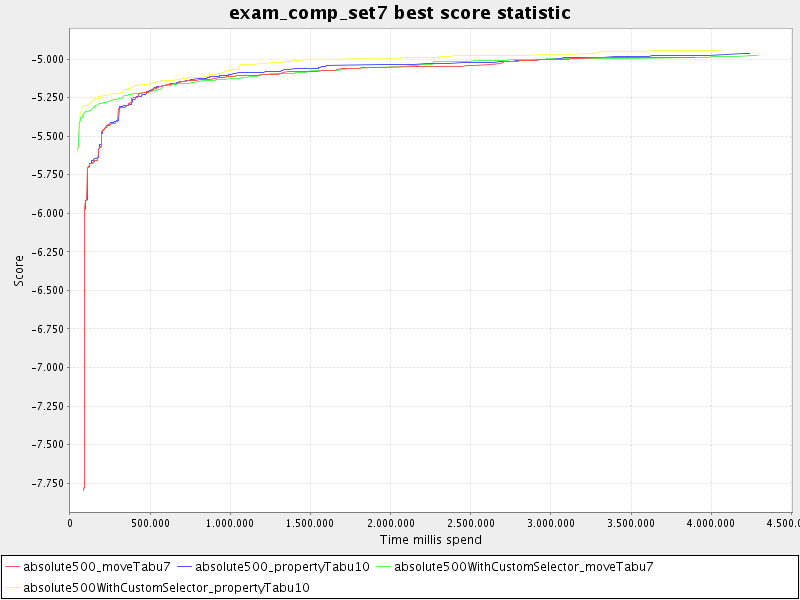Drools Planner supports several solver types, but you're probably wondering which is the best one? Although some solver types generally perform better then others, it really depends on your problem domain. Most solver types also have settings which can be tweaked. Those settings can influence the results of a solver a lot, although most settings perform pretty good out-of-the-box.
Luckily, Drools Planner includes a benchmarker, which allows you to play out different solver types and different settings against each other, so you can pick the best configuration for your problem domain.
You can build a Benchmarker instance with theXmlSolverBenchmarker.
Configure it with a benchmarker configuration xml file:
XmlSolverBenchmarker benchmarker = new XmlSolverBenchmarker();
benchmarker.configure("/org/drools/planner/examples/nqueens/benchmark/nqueensSolverBenchmarkConfig.xml");
benchmarker.benchmark();
benchmarker.writeResults(resultFile);
A basic benchmarker configuration file looks something like this:
<?xml version="1.0" encoding="UTF-8"?>
<solverBenchmarkSuite>
<benchmarkDirectory>local/data/nqueens</benchmarkDirectory>
<inheritedUnsolvedSolutionFile>data/nqueens/unsolved/unsolvedNQueens32.xml</inheritedUnsolvedSolutionFile>
<inheritedUnsolvedSolutionFile>data/nqueens/unsolved/unsolvedNQueens64.xml</inheritedUnsolvedSolutionFile>
<inheritedLocalSearchSolver>
<scoreDrl>/org/drools/planner/examples/nqueens/solver/nQueensScoreRules.drl</scoreDrl>
<scoreDefinition>
<scoreDefinitionType>SIMPLE</scoreDefinitionType>
</scoreDefinition>
<termination>
<maximumSecondsSpend>20</maximumSecondsSpend>
</termination>
<selector>
<moveFactoryClass>org.drools.planner.examples.nqueens.solver.move.factory.NQueensMoveFactory</moveFactoryClass>
</selector>
<forager>
<pickEarlyType>NEVER</pickEarlyType>
</forager>
</inheritedLocalSearchSolver>
<solverBenchmark>
<name>Solution tabu</name>
<localSearchSolver>
<acceptor>
<completeSolutionTabuSize>1000</completeSolutionTabuSize>
</acceptor>
</localSearchSolver>
</solverBenchmark>
<solverBenchmark>
<name>Move tabu 5</name>
<localSearchSolver>
<acceptor>
<completeMoveTabuSize>5</completeMoveTabuSize>
</acceptor>
</localSearchSolver>
</solverBenchmark>
<solverBenchmark>
<name>Move tabu 7</name>
<localSearchSolver>
<acceptor>
<completeMoveTabuSize>7</completeMoveTabuSize>
</acceptor>
</localSearchSolver>
</solverBenchmark>
<solverBenchmark>
<name>Solution tabu and move tabu 7</name>
<localSearchSolver>
<acceptor>
<completeSolutionTabuSize>1000</completeSolutionTabuSize>
<completeMoveTabuSize>7</completeMoveTabuSize>
</acceptor>
</localSearchSolver>
</solverBenchmark>
</solverBenchmarkSuite>
This benchmarker will try 4 configurations (1 solution tabu, 2 move tabu's and 1 solution-move tabu) on 2 data sets (32 and 64 queens), so it will run 8 solvers.
Every solverBenchmark entity contains a solver configuration (for example a local search
solver) and one or more unsolvedSolutionFile entities. It will run the solver configuration on
each of those unsolved solution files. A name is optional and generated if absent. The common
part of multiple solverBenchmark entities can be extracted to the inherited
entities and can be overwritten per solverBenchmark entity.
You need to specify a benchmarkDirectory (relative to the working directory).
A summary statistic and the best solution of each solver run will be written in that directory.
The benchmarker supports outputting the best score over time statistic as a graph and a CSV (comma separated values) file. Here's an example of a graph:
To configure graph and CSV output of the best score over time, just add a
solverStatisticType line:
<solverBenchmarkSuite>
<benchmarkDirectory>local/data/nqueens/solved</benchmarkDirectory>
<solverStatisticType>BEST_SOLUTION_CHANGED</solverStatisticType>
...
</solverBenchmarkSuite>
It will output all graphs and CSV files in the benchmarkDirectory.
